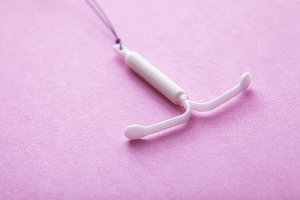 An intrauterine device (IUD) is a small t-shaped device inserted into the uterus to provide birth control. There are 5 types of IUDs currently available in the United States. Four of the available IUDs contain a progesterone called levonorgestrel and they include Mirena, Lilletta, Kyleena and Skyla. Paragard is a copper-containing IUD, and it is the only non-hormonal IUD. You can discuss IUDs in more detail with you doctor and they help you determine whether or not you are a good candidate for an IUD and which IUD is right for you.
An intrauterine device (IUD) is a small t-shaped device inserted into the uterus to provide birth control. There are 5 types of IUDs currently available in the United States. Four of the available IUDs contain a progesterone called levonorgestrel and they include Mirena, Lilletta, Kyleena and Skyla. Paragard is a copper-containing IUD, and it is the only non-hormonal IUD. You can discuss IUDs in more detail with you doctor and they help you determine whether or not you are a good candidate for an IUD and which IUD is right for you.
How To Prepare For Your IUD Insertion Appointment
Wear comfortable clothing to you appointment. Please make sure you have had something to eat before you come to the office for your appointment. If you are hungry during the procedure, you may feel faint and can pass out during the insertion process.
About 30 minutes before your appointment, please take 600-800 mg of Ibuprofen (Advil or Motrin). This will help to ease any cramping you may have during and after the insertion.
If appropriate, your provider may prescribe a medication to be taken orally the night before you procedure. It is called cytotec or misoprostol. Misoprostol can help dilate the cervix and may allow for easier insertion of the IUD. Please follow the instructions on your prescription. You may experience some mild cramping after taking the misoprostol.
The IUD is typically inserted shortly after starting your menstrual cycle. You will be expected to provide a small sample of urine to perform a pregnancy test before the IUD is inserted. Your provider may perform sexually transmitted infection tests either before insertion or on the day of insertion.
Insertion Of The IUD
 You will be asked to position yourself in the stirrups on the bed just like when you have your routine pelvic exam. A speculum will be placed in you vagina to visualize the cervix. The cervix will be cleaned with a sterile soap. A measurement will be taken of your uterus to determine how to place the IUD in the correct position in the uterus. This may cause you to experience some strong cramps.
You will be asked to position yourself in the stirrups on the bed just like when you have your routine pelvic exam. A speculum will be placed in you vagina to visualize the cervix. The cervix will be cleaned with a sterile soap. A measurement will be taken of your uterus to determine how to place the IUD in the correct position in the uterus. This may cause you to experience some strong cramps.
To insert the IUD, it is placed in a slender plastic tube. The tube is inserted into the vagina and guided through the cervix into the uterus. The tube is withdrawn, leaving the IUD in place. The IUD has strings that trail into the vagina. These strings allow the IUD to be easily removed.
After the IUD is placed in the uterus, the strings are trimmed so that 1-2 inches extend past the cervix into your vagina. Once the strings are trimmed the speculum is removed and you are allowed to rest and recover from the procedure.
After The Procedure
Insertion of the IUD can cause cramping and discomfort. Taking over-the-counter ibuprofen before the procedure, and for up to 72 hours after the procedure will help reduce cramping. You can also use a heating pad to manage cramping.
What To Expect
You can expect to have light bleeding that can be irregular for several months after the IUD is inserted. Heavy bleeding is not expected with the hormonal containing IUDs and should prompt you to notify your doctor. It is not unexpected to notice a heavier and “crampier” periods with the non-hormonal, copper IUD.
 The strings should not bother you, but in rare cases your partner may feel them. If this occurs and it is a problem, your provider may be able to trim the strings further. In order to minimize the risk of an infection after placing an IUD, we recommend avoiding tampons and refraining from sexual intercourse for 7 days. You can use pads instead of tampons for bleeding.
The strings should not bother you, but in rare cases your partner may feel them. If this occurs and it is a problem, your provider may be able to trim the strings further. In order to minimize the risk of an infection after placing an IUD, we recommend avoiding tampons and refraining from sexual intercourse for 7 days. You can use pads instead of tampons for bleeding.
After waiting one week you can resume using tampons and having intercourse. At the appointment for your IUD insertion, you will be given a card with information about your IUD. It will have the date of insertion and recommended date for removal. Please keep this in a safe place for your reference.
Speak To Raleigh Gynecology To Learn More
If you are interested in learning more about IUDs and want to know if you are a candidate, contact our experienced staff at Raleigh. Our team is ready to answer questions you may have and help resolve any uncertainties you may be experiencing. To book an appointment or to ask a question, please call us at 919.636.6670 or schedule an appointment online.
